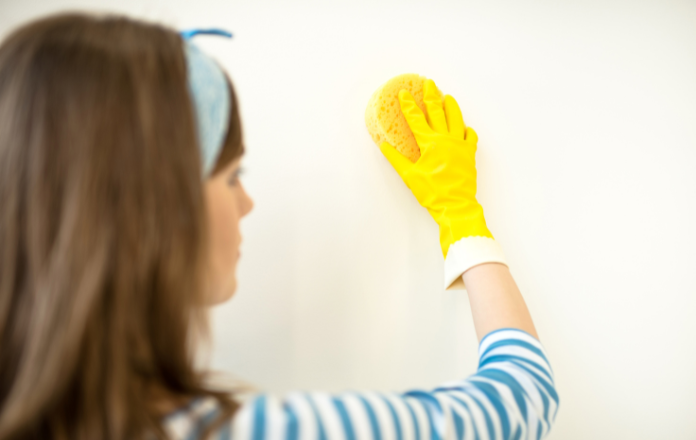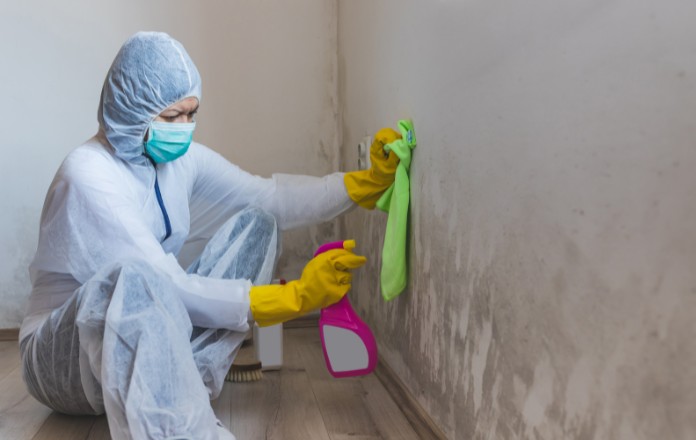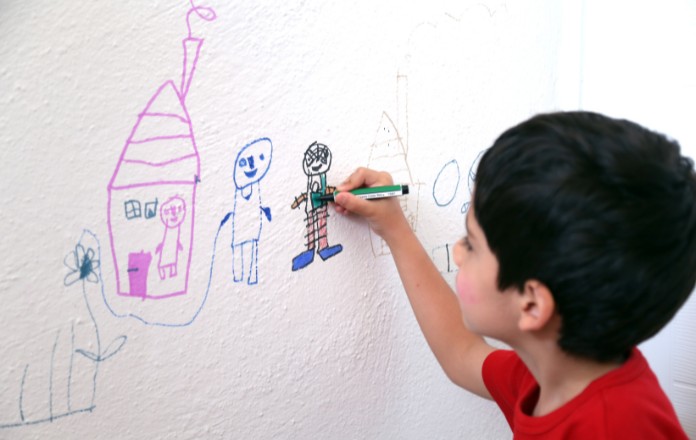
Unlike floors, walls are vertical surfaces which may lead homeowners to think that dust doesn’t accumulate and cleaning is not required. However, they can in fact be coated with dust, grease, smoke and insect droppings. If not cleaned, this may trigger allergic reactions and respiratory problems.
So, how do you clean your walls without damaging the paint? In this article, we share easy step-by-step processes of how to clean walls before and after painting, how to remove mould and how to clean off markings from walls if you have kids!
How To Clean and Prep Walls Before Painting
Before painting, it’s important to clean your walls to remove any dirt, grime and stains. High-quality paint products are able to bond well to almost any surface, but the adhesion will be enhanced with a clean and smooth surface.
Here’s how to clean your walls before painting!
Tools and materials required
To start with, gather the following tools and materials:
- Sponges or microfibre cloths
- Buckets
- Grease-cutting detergent like Selleys Liquid Sugar Soap
- Bleach
- Warm water
Step 1: Wipe the walls with a suitable solution

Typically, it’s sufficient to use a sponge and warm water to wipe the walls. But if you’re tackling an area that’s constantly exposed to oil such as the kitchen, you may need something stronger like a grease-cutting detergent diluted with some warm water.
Step 2: Wipe down with clean water
After cleaning the dirt and grime, dip another clean sponge or cloth in clean water. Wring till it’s damp and do a second wipe down to remove any soap residue.
Step 3: Allow walls to dry before painting
Lastly, give the walls some time to dry fully before you start painting. Painting while the walls are still damp can cause blisters or bubbles to form.
Tip!
It’s recommended to paint a layer of sealer before the paint colours are applied. A primer helps to improve the adhesion of subsequent paint layers, while hiding cosmetic flaws on the surface and preventing moisture from permeating through the wall.
How To Clean Painted Walls Without Removing The Paint
Did you know that uncleaned walls can worsen asthma and allergies? In fact, homeowners are advised to clean their walls at least once every 1 to 4 weeks to remove any dirt and dust that may accumulate.
The suitable cleaning frequency and materials used are dependent on the type of wall paint and paint finish as detailed here:
| Suitable materials | Suitable cleaning frequency | |
|---|---|---|
| Types of wall paint | ||
| Oil-based | Household detergents (diluted) White vinegar Water | Once every 1 to 2 weeks |
| Water-based | Multi-purpose cleaner Water | Once a month |
| Types of paint finishes | ||
| Flat or matte | Water | Once a month |
| Eggshell or satin | Dishwashing liquid Water | Once every 1 to 2 weeks |
| Semi-gloss or gloss | Household detergents (diluted) Water | Once every 1 to 2 weeks |
If you already have a freshly painted wall, read on for 4 easy steps to clean it without damaging the paint.
Tools and materials required
Before you begin cleaning, prep these tools and materials:
- Non-abrasive sponges or microfibre cloths
- Handheld vacuum or dusting brush with an extendable wand
- Buckets
- Multi-purpose cleaner like Selleys Liquid Sugar Soap
- Baking soda
- Rubbing alcohol
- Melamine sponge
- Warm water
Step 1: Get rid of dust

The first step is to get rid of the dust with a handheld vacuum or dusting brush with an extendable wand. Use a sturdy ladder to reach high spots and start from the top of the wall.
Step 2: Prepare a suitable cleaning solution
Next, prepare a cleaning solution that’s suitable for the type of interior paint that was applied on the wall. You can consider using a multi-purpose cleaner like Selleys Liquid Sugar Soap.
If you’re using a concentrated cleaner, ensure that an appropriate proportion of water is added to the solution to dilute it before use.
Step 3: Wipe the walls from top to bottom
It’s best to wipe the walls from top to bottom to prevent dirty water from dripping onto cleaned parts. Once you’re done cleaning with the solution, dip a clean sponge or cloth in a bucket of clean water, wring it well and wipe the walls to remove any remaining residue.
Step 4: Remove stubborn stains
If there are any stubborn stains, dip the damp sponge in a bit of baking soda and rub the stains off. Other methods you can try are using rubbing alcohol on a sponge or a melamine sponge.
How To Clean Mould Off Walls
Wear and tear is inevitable over time and may cause mould to grow on walls. It’s best to remove them in a timely manner to prevent any health issues and allergies.
To eliminate mould effectively, mix a solution of water and household bleach in a 4:1 ratio. Wearing gloves and goggles, dip a sponge in the solution and wipe the mould. Let it sit for 3 to 5 minutes before wiping it off with a damp cloth.
Note that mould should be removed before any painting is done.
How To Prevent Mould on Walls
If there isn’t mould on the walls yet, it’s a good idea to take the following measures when painting to prevent them from growing!
1. Apply an antifungal solution before painting

Before painting commences, consider applying an antifungal solution like Selleys Rapid Mould Killer on the walls and leave it on for the duration instructed in the product description.
This way, you won’t have to worry about the growth of fungus or algae on your walls. Ensure that the surface is dry before moving on to the next step.
2. Apply a high-quality paint coat
The type and quality of paint you use help prevent mould growth as well. An example would be Nippon Paint’s Odour-less Easy Wash as it has antifungal, mould resistant and stain-resistant features to achieve a safe and long-lasting finish. It also produces minimal odour and boasts low VOC emissions, including formaldehyde, promoting a healthier indoor environment.
How To Clean Writing Off Walls

If your child is nurturing his inner Vincent van Gogh, there are sure to be instances of them drawing or accidentally getting markings on the walls. Here are some ways you can try to remove crayon stains:
- Spray with Selleys RP7 and wipe with a clean cloth
- Spray with multi-purpose cleaner and wipe with a damp cloth
- Dip a sponge in a solution of water and dishwashing liquid and wipe the stain in a circular motion
- Use a melamine sponge
When cleaning the walls, start gently as you may remove the paint or decolourise it if you rub too hard.
FAQs About Cleaning Walls
How to clean soot off walls?
Soot may be caused by several reasons such as a flash fire on the kitchen stove, a fireplace that’s not well-ventilated or a burning candle.
To clean soot off walls effectively, here’s what you need to do:
- Wear goggles, a mask and gloves
- Shift furniture out of the room or cover them with protective sheets
- Open the windows to ventilate the room
- Clean the walls with a vacuum and dusting brush
- Dry cleaning: Use a sponge specially designed to clean soot to go over the soot stains
- Wet cleaning: Dip a clean sponge in a solution of water and grease-cutting dishwashing liquid and wipe the surface
- Dry the walls with a clean cloth
- Vacuum the floor to clean up any dried soot that has fallen off
How to clean textured walls?
Textured walls such as brick add to the aesthetic of a home, but it can be harder to maintain due to the ridges and uneven surface.
For textured walls, it follows the same process as cleaning regular walls, but more thorough cleaning is required to reach all the nooks and crannies. It’ll also be good to do a spot test to check whether the cleaning agent used reacts well with your wall.
The steps are as follows:
- Get rid of the dust with a vacuum or dusting brush
- Mix a suitable cleaning solution
- Wipe the walls from top to bottom with the cleaning solution
- Wipe the walls again with a damp cloth
How to keep walls clean longer?
There are a few things you can do in between major cleanings to maintain the cleanliness of your wall, including:
- Avoiding smoke in the house e.g. smoking, burning candles, cooking
- Spot cleaning immediately if you see any markings or stains on the wall
Do I need a professional to clean my walls?
It depends on the condition of your wall. Dirt and minor mould and mildew can be easily cleaned and removed yourself. However, if the mould is serious and/or caused by a water leaking issue, it’s best to call a professional for assistance.
17 Popular Room Ideas in 2023 that Your Baby Boy will Love
